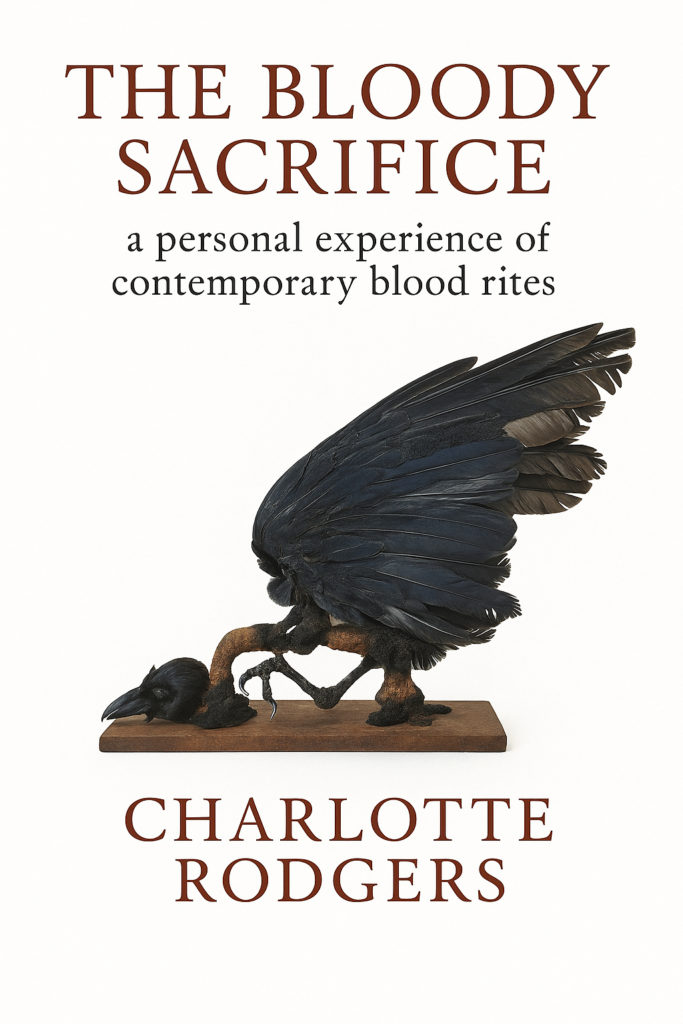
Category Archives: Spirituality
Rose Absolute

Important Notice – Shipping of Oils to the United States
Due to recent changes in tariffs and import regulations, we are temporarily unable to ship our oils to customers in the United States.
This restriction applies only to our oil products; all other items remain available for international shipping as usual.
We appreciate your patience and understanding while we review the new requirements and work to restore full service as soon as possible.
A 5ml bottle of Pure Rose Absolute £10.00, contains 10% essential oil in a 5ml dilution of organic grapeseed oil.”
“…the Rose is the Absolute Self-Sacrifice, the merging of all in the O (negative), the Universal Principle of generation through change (not merely the feminine), and the Universal Light ‘khabs’. (Aleister Crowley, The Confessions p. 192)

One of the scents that is closely associated with the divine feminine is that of the rose.
Rosa damascena is a type of shrub that can grow up to 2 metres high and has pink, fragrant flowers and grey-green leaves. It is mainly grown in Bulgaria, Turkey, and France and is one of three subspecies that are distilled for their perfume, alongside Rosa gallica and Rosa centifolia.
The Rose has such a beautiful and captivating scent; no wonder it’s considered one of the most powerful healing tools. Its frequency vibrates at 320 MHz, the highest frequency of all living and substantial things that we can experience with our senses. It’s amazing to think that something as simple as smelling a Rose can have such a profound effect on our well-being and bring us closer to feelings of love and healing.
*All oils in the Aromagick series are non-refundable and cannot be returned.
Blue Lotus Perfume Oil
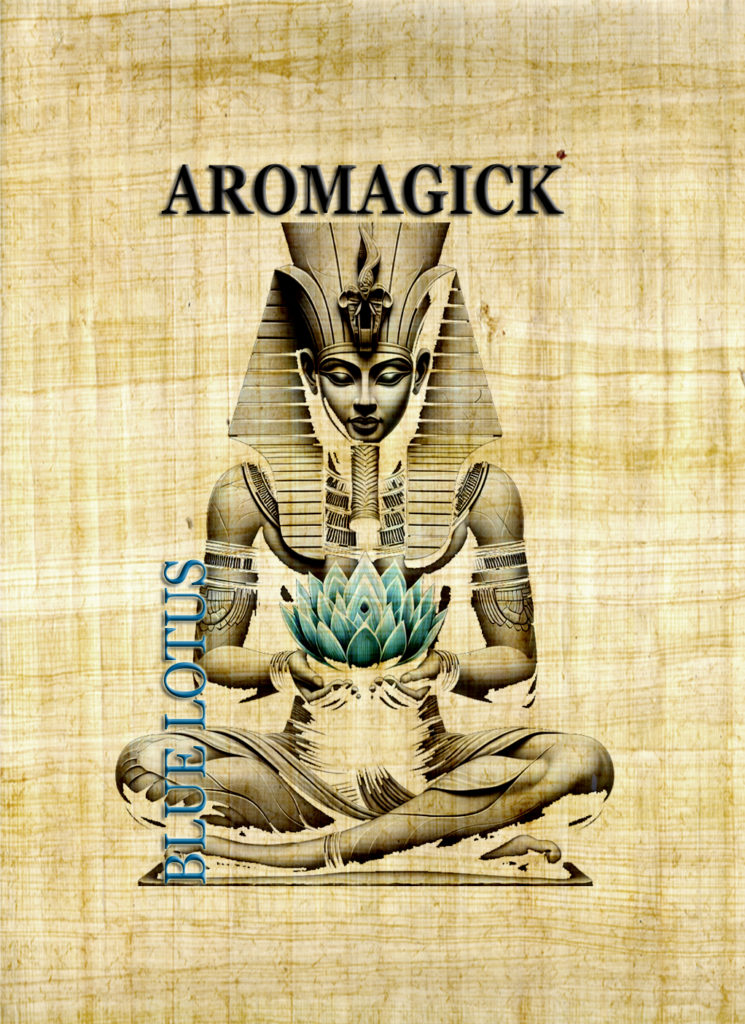
Important Notice – Shipping of Oils to the United States
Due to recent changes in tariffs and import regulations, we are temporarily unable to ship our oils to customers in the United States.
This restriction applies only to our oil products; all other items remain available for international shipping as usual.
We appreciate your patience and understanding while we review the new requirements and work to restore full service as soon as possible.
The unfolding petals of the Blue Lotus flower suggest the soul’s expansion. The growth of its pure beauty from the mud of its origin holds a spiritual promise. When Shiva requested the gift of knowledge from Kali, he embraced the thirst for knowledge that permeates the vast conscious universe. This is the same hunger that drives us to create art, music and life. The hunger that ignites in our hearts the passion to study and learn science, medicine, alchemy, philosophy and magic.
In both Egyptian and Hindu cultures, the Blue Lotus is well known for promoting spiritual growth, healing, balancing and rejuvenation.
The captivating scent of Blue Lotus Absolute essential oil is truly one-of-a-kind. Blending warm, spicy, sweet, and floral notes all at once, the fragrance has a complex intensity that is perfectly balanced with subtle refinement. The Egyptians and Hindus of ancient times believed that such exquisite smells were signs of the divine’s presence – symbols of transformation and rebirth. This theory has been extended to suggest that fragrances can shape our mental and emotional states as well. Upon first inhalation, Blue Lotus evokes a sense of longing for both the past and future; love is not far away. As the aroma fills your senses, they become filled with pure pleasure and appreciation for the physical world’s beauty. And with every breath, an overwhelming sense of euphoria begins to take hold – comforting us like a hug from the Goddess herself.
10ml bottle of pure Blue Lotus essential oil (1ml dilution in grapeseed oil)
Blue Lotus Perfume oil UK £15.00
*All oils in the Aromagick series are non-refundable and cannot be returned.
Pagan Heart of the West V
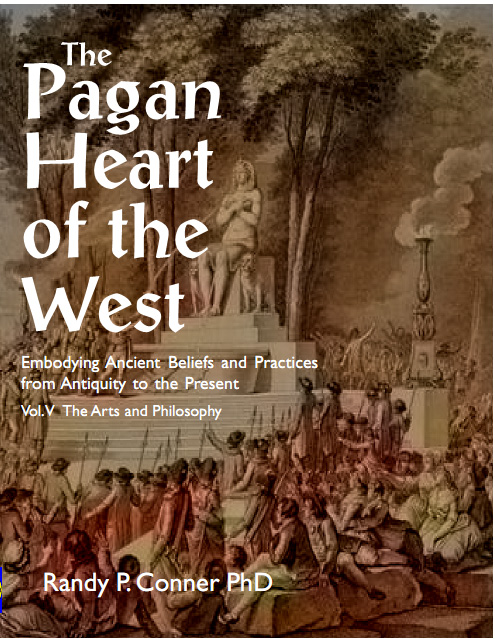
The Pagan Heart of the West:
Embodying Ancient Beliefs and Practices
from Antiquity to the Present
Vol. V The Arts and Philosophy
Randy P. Conner PhD
ISBN 9781906958909
£20.00+p&p /$28.00+p&p
Click HERE for UK edition
Click HERE for USA & Elsewhere
Get Pagan Heart of The West Quartet for only £65.00 postage free / UK
Get Pagan Heart of The West Quartet for only $100.00 postage free / USA (Elsewhere check fd)
In this fifth and final volume, we consider the persistence and transformation of pagan traditions in philosophy and the arts. This final volume also includes the extensive bibliography for the series.
The Pagan Heart of the West challenges current academic notions that paganism died when Christianization occurred; that the transition from paganism to Christianity was a fairly easy, nonviolent one; that persons once pagan were happy to accept the new religion because it fulfilled them or because they viewed it as superior – as if the Inquisition never happened; and that all things pagan are Christian before the mid-twentieth century, even though they demonstrate little or no connection to the Christian New Testament. Likewise, Pagan Heart challenges narrow conceptions of “the West.”
Applying Indigenous and decolonial theories, together with Michel Foucault’s conception of subjugated knowledge, Pagan Heart suggests that instead, paganism should be explored as an ancient and indigenous set of common beliefs and practices, at once ubiquitous and local, that includes the reverence of deities; the veneration of nature; rites celebrating the seasons and the life cycle; practices of healing, divination, and magic, often guided by ritual specialists; and arts and philosophies giving expression to pagan figures, concepts, and narratives.
Pagan Heart focuses on the utilization of theories that contest absolutist language supporting the so-called death of paganism; and on the worship and veneration of ancient deities and kindred beings. Like the other volumes, this volume demonstrates that paganism has not only persisted throughout millennia but that it has also undergone metamorphosis and innovation.
Most importantly, Pagan Heart emphasizes that the ancient gods did not die when Christian authorities forbade their worship and sought, in N. Scott Momaday’s terms, to commit deicide, but instead that they continue to exist and thrive.
Randy P. Conner, Ph.D., is the author of several works on the intersection of gender, sexuality, mythology, and the sacred. He teaches Humanities, including World Mythology, in the Chicago area.
Pagan Heart of the West III & IV
The Pagan Heart of the West
Volume III “Rituals and Ritual Specialists”
& Volume IV “Christianisation” (two volumes bound together)
Randy P. Conner PhD
ISBN-13: 978- 1906958893
£20.00+p&p / US$28.00+p&p
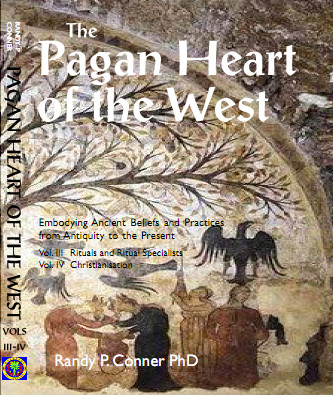
Click Here for UK edition
Click Here for USA & Elsewhere
Get Pagan Heart of The West Quartet for only £65.00 postage free / UK
Get Pagan Heart of The West Quartet for only $93.00 postage free / USA (elsewhere by wfd)
In these third and fourth volumes, Pagan Heart focuses on ritual specialists, including shamans and witches, and on the campaign of Christianization.
The Pagan Heart of the West challenges current academic notions that paganism died when Christianization occurred; that the transition from paganism to Christianity was a fairly easy, nonviolent one; that persons once pagan were happy to accept the new religion because it fulfilled them or because they viewed it as superior – as if the Inquisition never happened; and that all things pagan are in fact Christian prior to the mid-twentieth century, even though they demonstrate little or no connection to the Christian New Testament. Likewise, Pagan Heart challenges narrow conceptions of “the West.”
Applying Indigenous and decolonial theories, together with Michel Foucault’s conception of subjugated knowledge, Pagan Heart suggests that instead, paganism should be explored as an ancient and indigenous set of common beliefs and practices, at once ubiquitous and local, that includes the reverence of deities; the veneration of nature; rites celebrating the seasons and the life cycle; practices of healing, divination, and magic, often guided by ritual specialists; and arts and philosophies giving expression to pagan figures, concepts, and narratives.
In this first of five volumes, Pagan Heart focuses on the utilization of theories that contest absolutist language supporting the so-called death of paganism; and on the worship and veneration of ancient deities and kindred beings. Like the other volumes, this volume demonstrates that paganism has not only persisted over the course of millennia but that it has also undergone metamorphosis and innovation.
Most importantly, Pagan Heart emphasizes that the ancient gods did not die when Christian authorities forbade their worship and sought, in N. Scott Momaday’s terms, to commit deicide, but instead that they continue to exist and thrive.
Randy P. Conner, Ph.D., is the author of several works on the intersection of gender, sexuality, mythology, and the sacred. He teaches Humanities, including World Mythology, in the Chicago area.
Pagan Heart of the West II
The Pagan Heart of the West
Volume II “Nature and Rites”
Randy P. Conner PhD ISBN: 978-1906958886
£20.00+p&p / US$28.00+p&p
Kindle edition $9.99 / £ 7.17
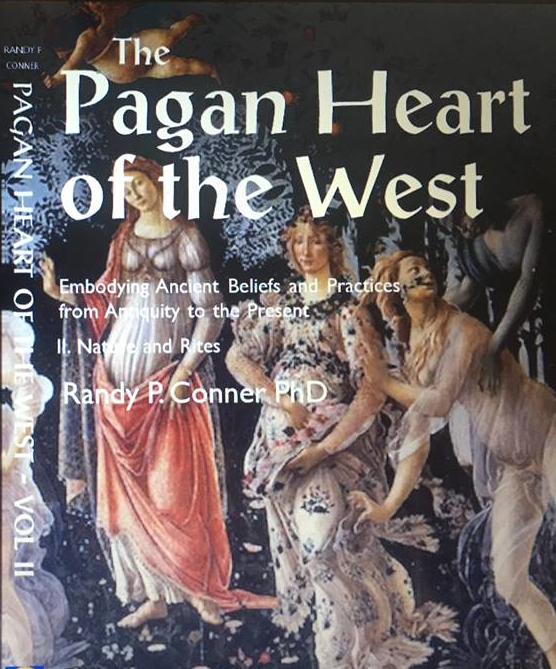
Click HERE for UK edition
Click Here for USA & Elsewhere
Click Here for the USA KINDLE edition
Click Here for the UK KINDLE edition
Get Pagan Heart of The West Quartet for only £65.00 postage free / UK
Get Pagan Heart of The West Quartet for only $93.00 postage free / USA
In this second volume, Pagan Heart focuses on the veneration of nature — flora, fauna, elements, celestial bodies — and on rituals of the seasons, life cycle, healing, divination, and magic.
The Pagan Heart of the West challenges current academic notions that paganism died when Christianization occurred; that the transition from paganism to Christianity was a fairly easy, nonviolent one; that persons once pagan were happy to accept the new religion because it fulfilled them or because they viewed it as superior – as if the Inquisition never happened; and that all things pagan are in fact Christian prior to the mid-twentieth century, even though they demonstrate little or no connection to the Christian New Testament. Likewise, Pagan Heart challenges narrow conceptions of “the West.”
Applying Indigenous and decolonial theories, together with Michel Foucault’s conception of subjugated knowledge, Pagan Heart suggests that instead, paganism should be explored as an ancient and indigenous set of common beliefs and practices, at once ubiquitous and local, that includes the reverence of deities; the veneration of nature; rites celebrating the seasons and the life cycle; practices of healing, divination, and magic, often guided by ritual specialists; and arts and philosophies giving expression to pagan figures, concepts, and narratives.
In this first of five volumes, Pagan Heart focuses on the utilization of theories that contest absolutist language supporting the so-called death of paganism; and on the worship and veneration of ancient deities and kindred beings. Like the other volumes, this volume demonstrates that paganism has not only persisted over the course of millennia but that it has also undergone metamorphosis and innovation.
Most importantly, Pagan Heart emphasizes that the ancient gods did not die when Christian authorities forbade their worship and sought, in N. Scott Momaday’s terms, to commit deicide, but instead that they continue to exist and thrive.
Randy P. Conner, PhD, is the author of several works on the intersection of gender, sexuality, mythology, and the sacred. He teaches Humanities, including World Mythology, in the Chicago area.
Pagan Heart of the West
Featured
Vol. I
Randy P. Conner PhD
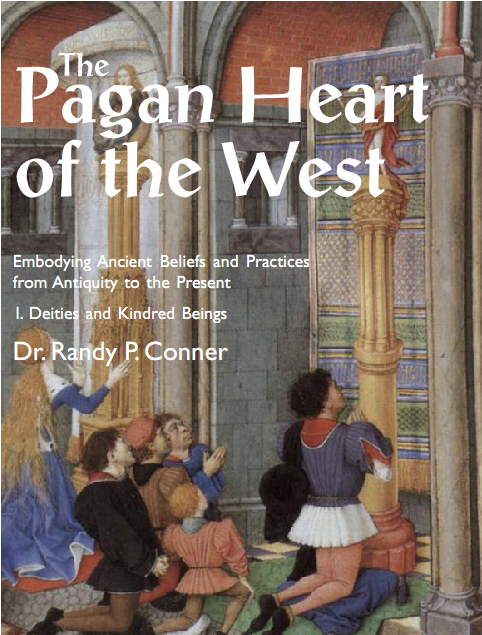
The Pagan Heart of the West challenges current academic notions that paganism died when Christianization occurred; that the transition from paganism to Christianity was a fairly easy, nonviolent one; that persons once pagan were happy to accept the new religion because it fulfilled them or because they viewed it as superior – as if the Inquisition never happened; and that all things pagan are in fact Christian prior to the mid-twentieth century, even though they demonstrate little or no connection to the Christian New Testament. Likewise, Pagan Heart challenges narrow conceptions of “the West.”
The Pagan Heart of the West:
Embodying Ancient Beliefs and Practices from Antiquity to the Present
Volume I “Deities and Kindred Beings”
Randy P. Conner PhD
ISBN-13: 978-1906958879
£20.00+p&p / US$28.00+p&p
Orders over £50 ($75) get free shipping
Click here to Buy UK edition
Click here to Buy USA & Elsewhere
Click HERE to buy the Pagan Heart of the West Quartet / £65 post free UK
Click HERE to buy the Pagan Heart of the West Quartet / $93.00 post free USA
Applying Indigenous and decolonial theories, together with Michel Foucault’s conception of subjugated knowledge, Pagan Heart suggests that instead, paganism should be explored as an ancient and indigenous set of common beliefs and practices, at once ubiquitous and local, that includes the reverence of deities; the veneration of nature; rites celebrating the seasons and the life cycle; practices of healing, divination, and magic, often guided by ritual specialists; and arts and philosophies giving expression to pagan figures, concepts, and narratives.
In this first of five volumes, Pagan Heart focuses on the utilization of theories that contest absolutist language supporting the so-called death of paganism; and on the worship and veneration of ancient deities and kindred beings. Like the other volumes, this volume demonstrates that paganism has not only persisted over the course of millennia but that it has also undergone metamorphosis and innovation.
Most importantly, Pagan Heart emphasizes that the ancient gods did not die when Christian authorities forbade their worship and sought, in N. Scott Momaday’s terms, to commit deicide, but instead that they continue to exist and thrive.
Randy P. Conner, Ph.D., is the author of several works on the intersection of gender, sexuality, mythology, and the sacred. He teaches Humanities, including World Mythology, in the Chicago area.
cover: Barthelemy d’Eyck, Emilie, Arcitas, and Palamon Praying to Their Respective Gods (c. 1465), illumination from Boccaccio’s Il Teseida Delle Nozze d’Emilia.
In this first of five volumes, Pagan Heart focuses on the utilization of theories that contest absolutist language supporting the so-called death of paganism; and on the worship and veneration of ancient deities and kindred beings. Like the other volumes, this volume demonstrates that paganism has not only persisted over the course of millennia but that it has also undergone metamorphosis and innovation.
PantheaCon 2020
Stop Press!!
Dr Randy P. Conner, author of The Pagan Heart of the West will be speaking at
The Final PantheaCon
Friday, February 14 – Monday, February 17, 2020
at San Jose Doubletree Hotel,
2050, Gateway Place,
San Jose, CA, USA.
For full details, speakers program and to book go to their website pantheacon.com/wordpress/
Email: info@pantheacon.com
Upperworld
Featured
Shamanism and Magick of the Celestial Realms
Chris Allaun
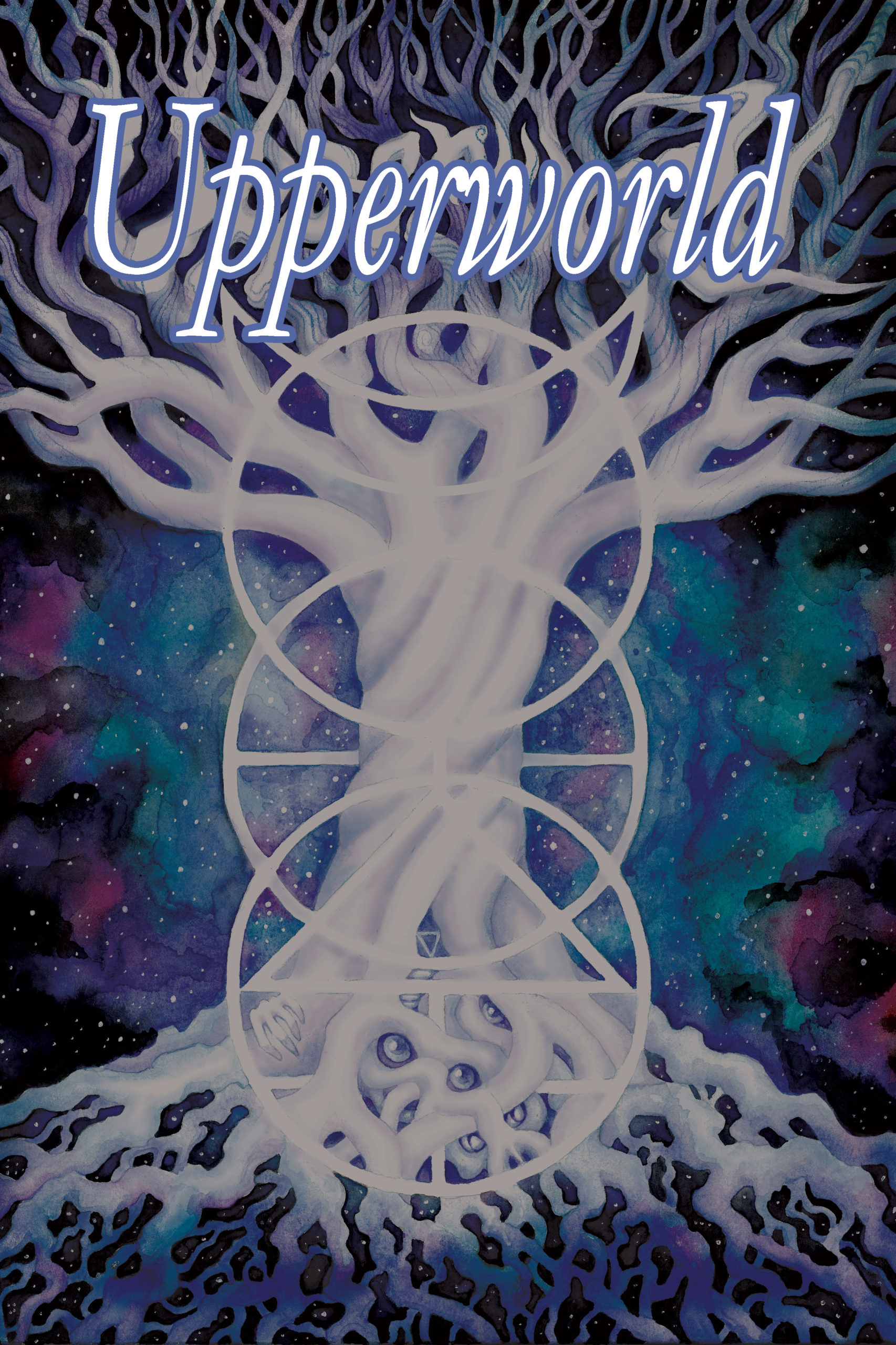
Upperworld: Shamanism and Magick of the Celestial Realms
Chris Allaun
ISBN: 978-1-906958-92-3
Format: Softcover
£15.00 / US$24.00
Subjects: Angels/Magick/Shamanism/Myths/Healing/Spirituality
Click HERE for Upperworld / UK
Click HERE for Upperworld / USA and AUS
The stars glow with their own special magick in the nighttime sky. For millions of years, the stars sent their light down to the earth. The same stars and planets we see today are the same bodies of light that ancient shamans saw around their campfires. Countless generations looked into the night sky and wondered about the magick above. It was the shamans who travelled in spirit to the Upperworlds to discover the secrets of the Universe. There are many ancient beings in the above worlds that can help us learn about the energies of the Universe and transform our lives for healing, power, and spiritual evolution.
As we journey into the Upperworlds, we will learn about the creation of the Universe and the energies that were formed from the first burst of energy and light. Shamans saw that these energies formed into powerful beings. Some called these beings angels, others called them ascended masters. Each of these beings has a divine purpose in the Universe and we will unravel these mysteries. We will learn to spirit travel into the many heavens from many different cultures. We will visit the heavens that were told to us in myths, as well as discover hidden parts of the Universe that await our arrival. We will also learn about the gods and goddesses and how to honour them in our daily magical practice. The gods are powerful and they can grant us many blessings. Through our magical practice with the night sky, we will use the magick of the stars and planets to transform our lives and the physical world around us.
“Like those before him, Christopher Allaun steals a little bit of the fire of heaven and shares it with his readers. While the underworld might be more in vogue these days, he tackles the rich lore of the heavens, and shares practical teachings that can be brought down to Earth for when you want to seek the stars.”
– Christopher Penczak, Co-Founder of The Temple of Witchcraft and author of City Magick, The Witch’s Shield and The Mighty Dead.
“Chris Allaun’s new book, “Upperworld”, is a very interesting and informative read. Consistent with his previous work, Chris focuses on the myths, legends and spiritual teachings of an eclectic mix of cultures from around the world, giving insights into their ways of viewing the “higher” realms. Chris gives information on the Shamanic worldview and the place of the Upperworld within it, detailing techniques to access and explore its various realms. Drawing on diverse sources, he not only describes the denizens of the various realms of the gods, angels, stars, planets and kabbalistic worlds but gives practical information on how to make contact and interact with them. There are rites of worship, magic, devotion, astral projection and healing that not only give an insight into the practical working of pagan, Shamanic experience but enable the reader to experience these themselves and take their own journey along the Shamanic path. This is an accessible and approachable work, both for the newcomer to the subject and the more experienced practitioner alike; both will derive benefit from reading this book.”
–Nigel G. Pearson, author of Treading the Mill: Workings of Traditional Witchcraft and The Devil’s Plantation: East Anglian Lore, Witchcraft, and Folk-Magick.
“Ancient shamans didn’t spend all their time journeying through the hazards of the underworld. They also took time to explore the heavens (or “Upperworld”), to learn the mysteries of creation, healing, and magick directly from the gods. It is refreshing, in this time when goetia is given so much focus, to see the author’s exploration of the concepts and spiritual beings of the celestial realms. Just as important, his focus upon lore, legend, and mythology in developing a true understanding of and shamanic relationship with these beings is vital, and often missed in modern Western occult texts.”
– Aaron Leitch, author of Secrets of the Magical Grimoires: The Classical Texts of Magick Deciphered and The Essential Enochian Grimoire: An Introduction to Angelic Magick from Dr. John Dee to the Golden Dawn.
Check out Chris Allaun’s news, classes, workshops and other events-
Chris Allaun: Author, Teacher, Healer
https://www.facebook.com/chrisallaun.author/?rc=p
Heart Vision: Tarot’s Inner Path
Featured
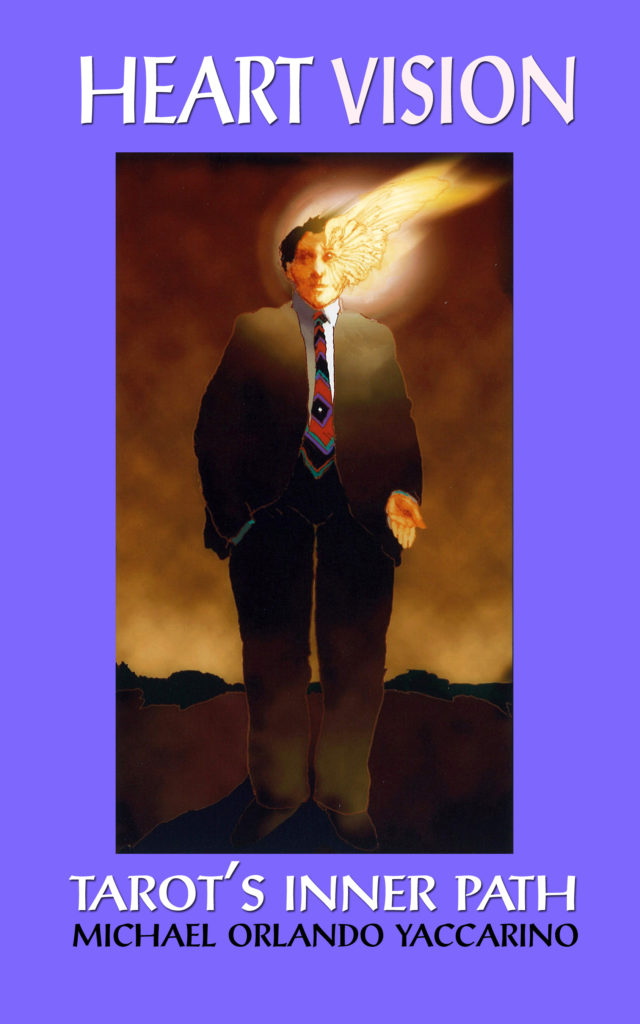
Michael Orlando Yaccarino
Foreword by Rachel Pollack
Afterword by Normandi Ellis
Format: Softcover
ISBN 9781906958817
£15.00+p&p / US$24.00+p&p
Click Here for USA edition
Click HERE for UK edition
Click here for Kindle UK edition
Click here for Kindle USA edition
—————————————————————–
Each of us is travelling upon an ever-evolving path toward greater illumination. The Tarot can provide deep awareness on many levels. Performed effectively, a Tarot reading encourages individual strengths, while proposing options to overcoming unhelpful blocks. Revelation unfolds within the open heart.
The mystical deck has fascinated both nonprofessional and paranormal scholars alike since its early development in the 15th century. Today, a myriad of books on using the cards to read to others is readily available. However, few works focus exclusively on the process of self-reading. Heart Vision: Tarot’s Inner Path is your in-depth, hands-on guide for a balanced path of discovery through the art of solitary reading.
Highlights include card-by-card message interpretations; a special focus on self-contemplation; the step-by-step process of self-reading unique to this work; and a variety of simple yet powerful spreads utilizing no more than six cards original to this book, many illuminated by actual self-readings. World-leading Tarot authority Rachel Pollack provides an insightful foreword. Award-winning author and specialist in Ancient Egyptian spirituality, Normandi Ellis offers an illuminating afterword. In addition to the wisdom of diverse spiritual traditions, the text includes exclusive comments by a variety of contemporary luminaries in the realms of the mystical and magical. And acclaimed artists Scot D. Ryersson, Gary Lund, and David Palladini all contribute to the book’s stunning illustrations. Enriched throughout by the wisdom of diverse spiritual traditions, in these pages, you will find an innovative pathway to inner transformation.
Front-cover art: Gary Lund
Back-cover art: David Palladini
Cover design: Scot D. Ryersson
The author has read, taught, and written about the Tarot for many years. He holds degrees in psychology and film studies from New York University. Previous books co-authored with Scot D. Ryersson include Infinite Variety: The Life and Legend of the Marchesa Casati, The Marchesa Casati: Portraits of a Muse, and The Princess of Wax: A Cruel Tale. Also with Ryersson, he co-edited Spectral Haunts and Phantom Lovers.
Visit the official Heart Vision website
Heart Vision: Book | Michael Orlando (casatiarchives.wixsite.com)
Book Reviews:
“Probably one of the best books on the Tarot that I have ever read. A must for all Tarotists.” —Anthony Pearson-Moorhouse, The Elvish Taylor and Owner/Partner of Sacred Earth (Suffolk, United Kingdom)
“Yaccarino’s approach to the Tarot is direct and invigorating, with the emphasis on self-reading. As a rule of thumb, I often test the inherent magickal quality of any such tome by opening it at random and letting my eye alight on the first words I see. In this case, the book opened at the King of Cups, which was disturbingly accurate. With the attitude of ‘Okay, but what else can you tell me?’, it then opened to the Nine of Pentacles. Again, exquisitely apt. In essence, with this clear and lucid book, you can know it works.” —Alan Richardson, author of numerous books on magick, magicians, and Earth mysteries, including Priestess: The Life and Magic of Dion Fortune and Earth God Risen
“A beautiful book, flowing and inviting, presented with an openness and clarity in both writing and visuals.” —Gary Lund, award-winning painter, sculptor, and animation film designer
“It is through the imagery of Tarot that Yaccarino explores each of the arcana. As Heart Vision unfolds, Michael skillfully guides us through the deck, deftly bringing our attention to the hidden, background imagery and the ‘veiled aspects’ of each card. But it’s not all about the iconography: a comprehensive range of spreads are given, with some very interesting variations. There are also examples of readings that demonstrate how the interpretative process unfolds. Little gems of wisdom are scattered through the pages, culled from Yaccarino’s clearly extensive reading and conversations with contemporary practitioners. This is an excellent introduction to the Tarot, and an enjoyable and illuminating text for the seasoned reader, too.” —from The Blog of Baphomet by Julian Vayne, author of Deep Magic Begins Here…: Tales and Techniques of Practical Occultism and Magick Works: Stories of Occultism in Theory and Practice
“The introduction to this book is penned by the renowned Tarotmancer Rachel Pollack. She describes this book as one of ‘distilled simplicity,’ designed for the apprentice but which has sufficient maturity and depth for seasoned readers too. It is focused on the solitary reader for self-analysis, offering a unique approach to the visionary dreaming world to nourish heart and soul by awakening the mind. After a brief but concise history of the Tarot, Michael leads the reader into a vivid perspective of mystical imagery as the art of vision within Reality. It serves as a potent tool, drawing the reader to attend the hermetic sciences and its philosophies to fulfil a divine purpose—not as amusement or entertainment. The pursuit of wisdom is ever the key. Emphasising the distinctions of revealed and veiled messages, it explains how these build upon one another to synergise profound insight. Michael provides a break-down of the Arcana into elemental suits, injecting innovative expression into their multi-layered symbolisms. He then introduces several original spreads providing unique formats, including those aptly named ‘The Crossroads’ and ‘The Bridge.’ Ranging from a single spread to six cards, they encompass all needs and situations, guiding the reader always towards decisive understanding and self-awareness as a means of access to their inner dialogue. Intent is captured at source. The reader is made aware of the folly of this tool as a means of prediction, a waste of soul talent that erodes free will and hope. Instead, it instils hope through the engagement of the sacred harmony that can be achieved through self-expression and fulfilment. With lucid equanimity, Michael directs the reader to engage that precious dynamic to manifest the message as translatable instruction. Using multi-disciplinary techniques, the ‘happening’ Michael refers to becomes a transformative engagement of the mysteries proper through the miraculous art!” —by Shani Oates, author of The Devil’s Crown: Key to the Mysteries of Robert Cochrane’s Craft and The Arcane Veil: Ten Discourses on the Craft and the History of Magic
TAROT, DIVINATION & SPIRITUALITY
Deeper Into The Underworld
Featured
Death, Ancestors & Magical Rites
Chris Allaun
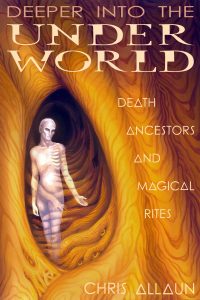
Deeper into The Underworld
Death, Ancestors & Magical Rites
Chris Allaun
Format: Softcover
ISBN: 978-1-906958-82-4
£15.00 /US $24.00
Subjects: Shamanism/Magic/Healing/Afterlife/Death Customs/Spirits Communication/Spirituality.
Deeper into the Underworld we go…
The Underworld is home to our beloved ancestors, those who gave us our flesh and blood and our breath. Their blood flows through our veins and contains great magick and power. They have the ability to help us heal old karmic wounds of the past and aide us in our spiritual development. They can teach us many things about the world of spirit. All we have to do is honor them. All we have to do is call to them.
The cycles of Life are sacred to our pagan and magical cosmology, but what of Death? As we honor life, so, too, must we honor the sacredness of death and dying. As we go further in our Underworld studies, we will learn about the Angel of Death and energetic process of dying. Death is not the end. It is a magical transition into the world of spirit where we are rejoined with our beloved ancestors. The Ancestors are our link to our past. We will learn to honor them and create a sacred shrine so that we may commune with them in a magical and healing way. By honoring the ancestors, we will strengthen our bonds with the spirits and learn to heal our family karma that began long ago and affects us even today.
By learning to work with the ancestors, we will learn to work with the spirits of the dead for magick and healing. We will learn how ancient cultures summoned the beloved dead to heal grief and say final goodbyes. We will also learn magical techniques to summon the shades of the dead and the Hidden Company; those powerful spirits that can teach us ancient wisdom of long ago that can help us tread our spiritual path to find balance and healing.
Click here for Kindle UK edition
Click here for Kindle USA edition
Read Alanna Wright’s review of Deeper Into the Underworld: Death, Ancestors and Magical Rites, published in Spiral Nature Magazine
www.spiralnature.com/reviews/deeper-into-underworld-chris-allaun/
Deeper Into the Underworld: Death, Ancestors and Magical Rites
by Chris Allaun
Mandrake of Oxford, 9781906958824, 203 pp., 2018.
”Chris Allaun has released Deeper Into the Underworld: Death, Ancestors and Magical Rites as a follow-up to his first book Underworld: Shamanism, Myth and Magick. In this book, Allaun brings to life, or rather life after death, the powerful practice of ancestral spirit worship and highlights the immense spiritual benefits that come from learning to commune with the deceased. The theme of death runs strong through the book yet Allaun has presented the material in such a way that allows the reader to open to the power of Underworld forces in much the same way as shamans, witches, and magicians have for countless centuries — with the knowledge needed to access this realm, courage to face the reality of death and wisdom to tap into the spiritual power of this domain.
Written in a very straightforward and easy-to-read style, Allaun provides the reader with real-life experiential advice on how to work with ancestors as part of their magical practices. He explains,
“Honoring the dead is one of the most important parts of spirituality. We often honor our gods and goddesses and even nature spirits, but sometimes forget the most important spirits to honor; our beloved dead. Our ancestors are our family. They are our grandmothers and grandfathers and our grandmothers and grandfathers before that. They hold an energetic and magical link to us. We may not realize it, but there is a current of power that goes from us to our ancestors and from them back to us. It is strong. It is powerful. Is it the bond of family.”
In no way does Allaun skimp on ideas for how to establish and strengthen this connection to our ancestors. He offers a variety of methods that can be easily incorporated into one’s magic to help the reader open the channel to commune with their ancestors. Detailed is the way to set up an altar, created sacred space and maintain a daily devotional practice to honour loved ones who have passed on. Allaun highlights the importance of sustaining an ongoing relationship with our ancestors, rather than only honouring them sparsely through the year, as the way to truly bring them into your home and spiritual life. In this way, we can begin to communicate with our ancestors about day-to-day happenings and this in turn provides nourishment for them and us alike.
The reader is reminded this is not a one-way relationship as our ancestors benefit too from our offerings to them in the Underworld. Allaun explains, “On an energetic level, what is happening is that our prayers open our minds, energies and our spirits to our Ancestors and higher beings to establish a strong and powerful connection. Through the connection we make with the spirits, they are able to use this energy and power to help our Ancestors evolve to a higher state of being.” Later in the book, Allaun ties in how we also carry ancestral patterns that we can transmute and heal by working with ancestors in the Underworld directly.
Beyond ancestral knowledge, this book is a rich resource for information on death rites, rituals, and cultural perceptions of death that have been carried through the ages. Allaun provides insightful understanding of the way death is portrayed today in comparison to how cultures of the past understood working with the Underworld, death, and the ancestors. These include pages on Egyptian embalming and also the Eleusinian Mysteries of Ancient Greece. By going back in time, the reader comes to understand how human’s cultural relationship to death has been worshipped, revered, and also feared throughout time.
Throughout the book, Allaun provides many mythological stories that highlight the importance of the Underworld spirits and knowledge of how to navigate this tricky realm. These include the story of Baldur’s dreams in Norse mythology, Those Who Come From The Mountains in Japanese and Shinto mythology and Asclepius and Diana bringing back the dead in Greco-Roman mythology. Allaun does an outstanding job of providing many cross-cultural narratives involving death, so the reader has a widened perspective of a variety of spiritual understandings of the Underworld. This includes a passage of the Ghost Dance of Native Americans from the Plains region of the United States, where they were able to perform this dance to summon their ancestors and gain a personal sense of empowerment through the connection.
In sharing his personal experience, Allaun works to dissolve the fear commonly associated with death and the Underworld. A fantastic aspect of the book is the fascinating meditations provided that can be applied in a ritual setting to gain insight into the energy of death, access the Underworld, and work with ancestors. These meditations include performing a eulogy at your own funeral, graveyard meditations, tracing back family karma through lineage, and connecting with ancestors in dreams, and tapping into the blood. For those who practice traditional witchcraft, Allaun includes a ritual to connect with the Hidden Company to seek their spiritual knowledge and also Ritual of the Rose Castle to connect with the Goddess of Death.
Allaun focuses on sharing with the reader how the misconception of working with the dead became linked to evildoing with rise of Judeo-Christianity. Yet, he is honest about the association that has existed between necromancy and black magickdea intended to harm others. While he does not advocate using ancestors or magical connections made to the deceased in this way, he does acknowledge the existence and possibility of the misuse of spiritual power, which include bringing the dead back to life.
Above all, Allaun maintains that it is of the utmost importance to treat the dead with the kindness the reader would show any guest in their home. This means being welcoming and never making unfair requests. While the ancestors can be strong magical allies, Allaun makes it clear that we should never force our ancestors to do things for us. It is important that honour is always maintained, as the spirits can communicate, and being disrespectful towards an ancestor could hinder future relations.
The information in the book covers what the reader would need to know on all fronts to begin establishing a spiritual connection with their ancestors. Allaun stresses the importance of carefully selecting the spirits with whom you share energy. He acknowledges that certain spiritual entities many want to ask favours or cling on to the reader in order to gain energy. While this does not always happen, Allaun has given the reader techniques that can be used to make sure the reader remains protected and the sacred space clear of unwanted energy. The information provided includes numerous measures of protection that range from simple techniques to create clear energy to elaborate banishing rituals. It is obvious that Allaun has the reader’s interest at heart and wants to provide the most honest and accurate account of the possibilities that can emerge from working with the energies of the Underworld to ensure the reader is prepared.
There are only a few downsides of note in regard to Deeper Into The Underworld. The first being quite a few spelling and grammatical errors scattered through the book that can be distracting. The other is that there is no reference section or bibliography provided, leaving the reader to research and verify the information themselves.
Overall, Deeper Into The Underworld: Death, Ancestors and Magical Rites is a great read for anyone who feels a connection to working with the deceased. There is much to be gained from tapping into the Underworld and bringing the wisdom of our beloved ancestors into the physical realm. Consider this a go-to book from which anyone with an interest in ancestral worship or necromancy would gain something.”
Secret Gospel of Mark
Featured
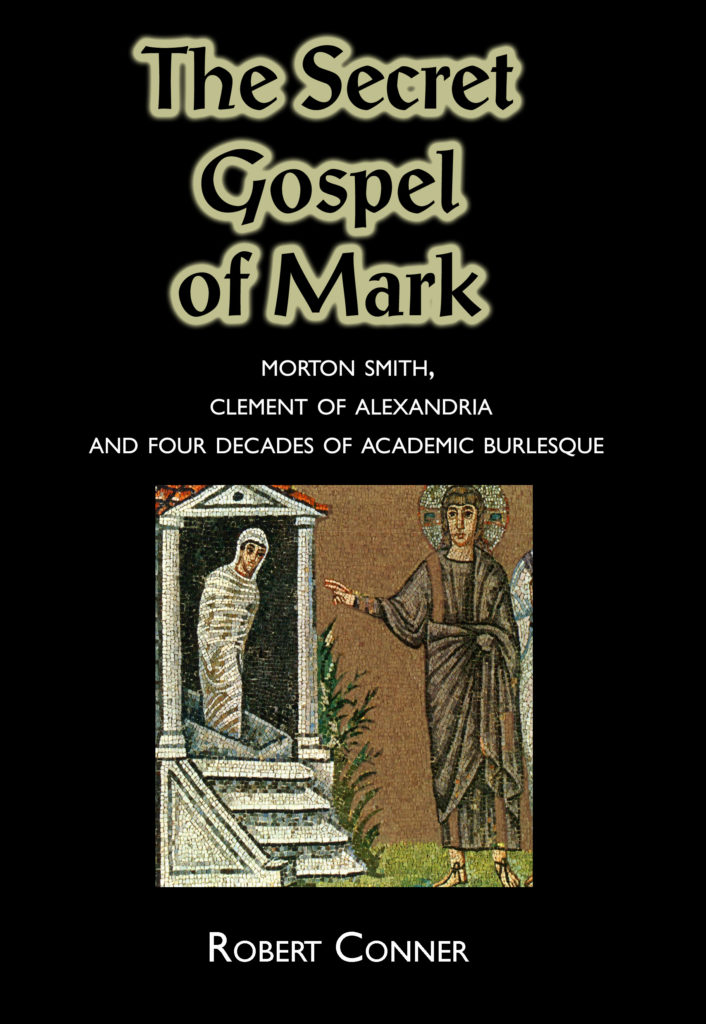
Morton Smith, Clement of Alexandria
and four decades of academic burlesque
Robert Conner
The Secret Gospel of Mark
Morton Smith, Clement of Alexandria
and four decades of academic burlesque
Robert Conner
Format: Softcover/160 pp.
ISBN: 978-1-906958-68-8
£15.00+p&p / US $24.00+p&p
Subjects: Religious Studies/Spirituality
Click HERE for USA
Click HERE for the UK Edition
While cataloguing material in the library of the monastery of Mar Saba in 1958, Morton Smith discovered a quotation from a letter of Clement of Alexandria copied in the end pages of a 17th-century collection of the letters of Ignatius. After more than a decade of a collaborative analysis of the find, Smith published his conclusions in 1973, setting off a firestorm of controversy in the New Testament studies guild.
In 1975, a Jesuit scholar, Quentin Quesnell, claimed the letter had been forged and implied that Smith was the forger, moving the focus of debate off the text itself and onto Smith. Since then the pages containing the letter have been removed from the book and possibly destroyed, while Catholic and evangelical writers, none of whom have ever seen the pages in question, continue to claim that Smith forged the letter.
Following his death in 1991, accusations against Smith took on a considerably more personal tone, highlighting his alleged homosexuality and by implication his dishonesty and moral perversity. Although the question of authenticity remains unresolved, the controversy has opened a window on the intellectually corrupt nature of apologetic New Testament studies, a subject of greater importance than the authenticity of early Christian texts.
The Dionysian Spirit
Featured
Sean Fitton
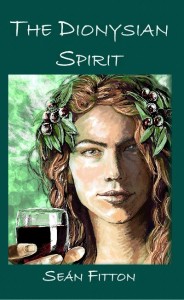
The Dionysian Spirit
Sean Fitton
Format: Softcover
ISBN: 978-1-906958-65-7
£15.00 / US$24.00
Subjects: Ancient Greece/
Greek Mysteries/Myths/Magic/Paganism/Spirituality.
Click Here for The Dionysian Spirit / USA
Click here for Kindle UK edition
Click Here for The Dionysian Spirit / UK
Click here for the Kindle USA edition
Dionysos is an obscure Greek god of wine and theatre for many people. For others, he is so much more.
The Dionysian Spirit examines the essence of what Dionysos is all about, both as a deity and as a cultural and social force. It looks at the relation of Dionysos with his opposite number Apollo. The twin gifts of Apollo and Dionysos are ekstasis (ecstasy) and entheos (enthusiasm) and have informed and enlivened our lives and cultures from ancient times right to the present day and beyond.
The Dionysian Spirit – like the art of a good party – has always been with us and now, in many ways, we need it more than ever.
Contents: Devotional to Dionysos / The Visualisation / The Myths of Dionysos / Dionysian Heroes / Dionysos Around the World / Dionysos Across The Millenium / Dionysos Goes Forth
Sacred Mountains
Featured
Stories of The Mystic Mountains
An Anthology
Michael Berman

Sacred Mountains
Stories of The Mystic Mountains
An Anthology
Michael Berman
Format: Softcover
ISBN: 9781906958220
£15.00 / US$24.00
Subjects: Shamanism/Mysticism/Spirituality/Myths & Legends.
Click HERE for Sacred Mountains / USA
Click HERE for Sacred Mountains /UK
On the mountains of truth, you can never climb in vain: either you will reach a point higher up today, or you will be training your powers so that you will be able to climb higher tomorrow.
~ Friedrich Nietzsche
What mountains mean to me: in one word, awe-inspiring. Although we can measure them, our minds are incapable of actually grasping the very small or the very large things in nature: neither atomic particles nor astronomical distances. How big is a mountain, how much does it weigh? Our limited minds can only cope with subjective assessments such as how difficult is it to climb, how dangerous would an avalanche be? So the feelings it produces are awe, a little fear, and possibly exhilaration if and when we think that we have conquered the mountain – but in reality we never can.
~ Professor David Hunt
All the stories presented in this collection contain shamanic elements, so the obvious starting point is to explain what is meant by this. The term ‘shaman’ is a controversial one. Initially employed by early anthropologists to refer to a specific category of magical practitioners from Siberia, the term is now widely used to denote similar practitioners from a variety of cultures around the world. This application of an originally culture-specific term to a more general usage has caused problems with regard to definition, with disagreements among scholars over whether certain features, such as soul flight or possession, or certain types of altered states of consciousness, should or should not be listed among the core characteristics of shamanism.
(Wilby, 2011, p.252.)
Introduction
What are Mountains for you?
Soul Captivation on White Bone Mountain
The Magic Brush and the Golden Mountain
The Legend of Amirani
The Story of Jumping Mouse
The Children of Hamelin: A Shamanic Journey into Mount Poppenberg
The Crystal Clear Waters of Mount Elbruz
The Vision Quest, Mount Sinai, and a Dream Fulfilled
Mount Ararat
Mount Koya-san, the Hermit’s Cave, and Fujiyama
Sacred Towers
The Fool on the Hill and the Book of Mysteries
The Tobacco of Harisaboqued
The Princess of the Tower
Appendix:
The Baal Shem Tov –
Rabbi, Religious Formulator or Shaman?
***
cover photograph by Joe Page shows Rennes Le Château seen from castle of Rennes Les Bains.
—
Launch 17th of January 2012 at the Georgian Embassy the author will talk about this book and give a reading. Starting promptly at 7.30 pm. The event is free and Georgian wine will be served at no cost too. The address is 4 Russell Gardens, West Kensington, London W14 8EZ. The hall holds about 60 people and we are hoping for a full house.
—
*************************************************************************************
RESOURCES FOR THE SACRED MOUNTAINS EXPERIENCE
Arts & Culture, Folklore, Myths & Legends, Food & Drink.
*************************************************************************************
Tbilisi Opera & Ballet Theatre
www.opera.ge
*
Georgia Cradle of Wine
www.georgia.gov.ge/5225
*
TAMADA,
Authentic Georgian Restaurant,
122 Boundary Road, St John’s Wood,
London NW8 0RH, UK.
www.tamada.co.uk
*
A Contemporary Western Book Of The Dead
Featured
An Anthology
Edited by Charlotte Rodgers & Lydia Maskell
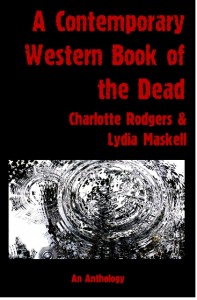
A Contemporary Western Book of The Dead
An Anthology
Edited by Charlotte Rodgers & Lydia Maskell
Format: Softcover
ISBN: 978-1-906958-04-6
£15.00 +P&P / US$22+P&P
Click HERE for UK edition
Click HERE for USA & Elsewhere
Click here for Kindle UK Edition
Click here for Kindle USA edition
‘I was musing on Singapore in all its affluent glory still having shrines for the dead on every street corner during ‘The Festival of the Hungry Ghosts’. Then I was musing on how the socially mobile of modern western society eschew death rites and grieving in the name of ‘holding it together’ and being progressive. I thought of which civilizations are falling and which are rising again, and wondered whether acknowledging death and the ancestors is a vital part of a maintaining personal identity and our place in society. I remember how my grieving father mourned for all the information he had relied on his deceased wife remembering; information which was now lost. I recalled Michael Crichton’s words ‘If you don’t know (your family’s) history, then you don’t know anything. You are a leaf that doesn’t know it is part of a tree.’
Then I thought maybe someone should write about the cults of the ancestors and death, perhaps an anthology, perhaps cross relate experiences of loss to personal spirituality and magick and history. I know that years of working with the dead in the name of art and spirituality, didn’t prepare me for the death of my mother. What helped me was the advice of someone from a long tradition of working with the ancestors. I think that collecting the experiences of spiritual practitioners in their working with grief and death is part of a living and necessary tradition that will give respect to the dead and strength, identity and support to our own personal spirituality.’
Within this book are rituals, stories, traditions and experiences of magicians’ scholars and artists who work with death. Some of the contributors such as Nema, Mogg Morgan, Louis Martine and Nevill Drury (to name but a few) have helped define contemporary transformative spirituality. Others are less well known but just as learned. As there should be in such a collection there is comedy, anger confrontation and practicality. This anthology is about who we are, and where we come from. It is also about how we change. A Contemporary Western Book of the Dead contains voices and visions that acknowledge our past, feed our present and guide the direction of our future.
Introduction/Charlotte Rodgers
Loved One/Nema
All a Do about Death /Josephine McCarthy
Clans For The Memory / Sarah Grimstone
Learning About Death / Nevill Drury
A Thoughtful Wake / Louis Martinie
Break On Through To The Other Side /Louise Hodgson
Death the Final Frontier / Sue Fox
The Bardo Thodol – Bon Voyage / John Power
You Only Live Twice / Ode bi Tola
On Speaking with the Dead: The Cult of the Dead in Traditional Culture / Michael Clarke
Body / Mishlen Linden
The Great Western Hoax / Ode bi Tola
The Book of Gates: A prose arrangement / Mogg Morgan
Biographies of Contributors
Photographers:
Sue Fox, Ruth Kenyon, Ariadne Spyridonos Xenou (Cover: Gerald Hutton)
Merlin’s Mound
Nigel Bryant
(Magical Fiction)
(Arthurian Myths & Legends)
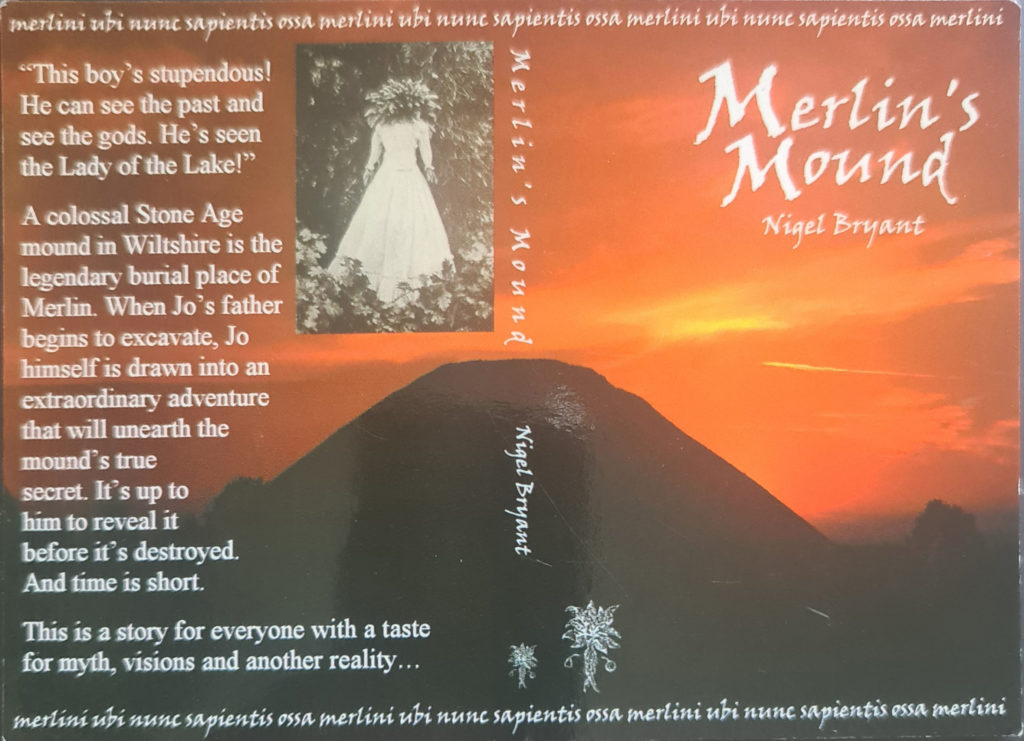
Merlin’s Mound
Nigel Bryant
Format: Softcover
£10.00/US$15.00
Subjects: Magical Fiction/Grail & Arthurian Myths & Legends/Spirituality.
“a wonderful book… in the same category as Alan Garner and Susan Cooper” Professor Ronald Hutton
‘This boy’s stupendous! He can see the past and see the gods. He’s seen the Lady of the Lake!’
A colossal Stone Age mound in Wiltshire is the legendary burial place of Merlin. When Jo’s father begins to excavate, Jo himself is drawn into an extraordinary adventure that unearths the mound’s true secret. It’s up to him to reveal it before it’s destroyed. And time is short.
‘A week ago he’d have laughed at this. Now he’s on the edge of a whole new world.’
This is a story for everyone with a taste for myth, visions and another reality…
About the book:
The Stone Age monuments at Avebury in Wiltshire are world-famous, attracting thousands of visitors each year. Two of the most dramatic are the enormous burial chamber known as the West Kennet Long Barrow, and Silbury Hill, the largest man-made mound in Europe. Less well known is Silbury’s “sister” mound at Marlborough a few miles due east, but this is nothing less than the legendary burial place of Merlin.
These extraordinary sites are the key locations of the novel Merlin’s Mound. In the novel, an adolescent is awakened startlingly to the meaning and original purpose of these locations. This story will appeal to everyone from the protagonist’s age and older who enjoys myth, legend, and visions. Marlborough is surely the only town in Britain with an Arthurian motto – “WHERE NOW ARE THE BONES OF WISE MERLIN”
REVIEWS
From Dragon’s Wood Magazine:
‘Meet Joel (Jo). He’s a nice lad. He likes football, he misses his mother (who is no longer with his dad), and he has the misfortune to have an obsessive and arrogant archaeologist for his father. Jo’s dad takes him on a dig in Marlborough Wiltshire to excavate what is locally known been as Merlin’s Mound. Jo really doesn’t want to be there, he would rather be watching football or playing computer games. Indeed he calls Silbury Hill ‘another pile of prehistoric pointlessness’. Jo’s relationship with his father is fraught at best and certainly not helped by some of the comments his father makes to his son.
Things start to happen…
Jo meets Dag, Gareth and Mort, three enigmatic characters who will play an interesting role as the story unfolds. Joe starts to realise that things are happening, things that he has no explanation for, things that will cause him to question and wonder. As time goes on Jo is more and more against the excavation of the Mound. He ‘knows’ that below the ground something or someone is still in residence. Is it Merlin? His father is convinced that the Marlborough site is a burial mound of someone pretty special and that somewhere in the mound four and a half thousand-year-old treasure is waiting for him to get his grasping hands on. He doesn’t subscribe to the Merlin theory, however. Jo on the other hand becomes more and more convinced that digging the mound is the wrong thing to do. It becomes his mission to reveal the true secret of the site and time is running out. What is that secret and ce of will Jo succeed?
Published by Mandrake of Oxford, Merlin’s Mound is listed on their website under the ‘young fiction’ genre. Certainly, the content of this book will appeal to teenagers. However that should not deter older readers. I found this both entertaining and interesting and certainly some light relief from all those other heavy books we pagans tend to read.
The author Nigel Bryant, whose involvement with Arthurian matters is long-standing and obvious from the way he writes, brings the reader a lively contemporary tale which often challenges our ideas on modern archaeology. I was left wondering whether or not digging up the past is always the right thing to do. This is the type of story that is great for us oldies to read on lazy summer afternoons in the back garden. Youngsters will no doubt identify with the often anxious adolescent that Jo is and I highly recommend it to anyone from about 15 years old. ‘
More reviews
Druid Network:
This is a book aimed at a ‘teenage’ audience, and it’s easy to see the central character appealing to many a surly teenager! But this the tale of a special teenager with special gifts, which link everyday events and archaeology – the never-ending search for scientific ‘truth’ and knowledge – to the sacred within and around us all, and to the sacred landscape of Wiltshire.
But it is a work that can be read and enjoyed by any age, the story is a timeless tale, one that holds the reader spellbound, fully involved with events and engaged with the participants. The monuments of Avebury and Merlin’s Mount at Marlborough come alive on the pages, and the less well known mound of Merlin Mount is central to the whole story, as the title suggests!
The tale is well written and flows beautifully and evocatively, pulling the reader in and giving real involvement with what is happening, and how the mystery will unravel. Highly recommended.
NIGEL BRYANT v DAN BROWN
MERLIN’S MOUND author Nigel Bryant appeared on ITV’s much-publicised programme The Grail Trail (25.9.05) to attack the vision of the Holy Grail in Dan Brown’s THE DA VINCI CODE.
“It may seem strange,” he says, “that I laid into Brown for using the Grail as a symbol of the womb, of the sacred feminine, when that very thing is central to MERLIN’S MOUND. But the difference is that I’m using it knowingly as a symbol. And I don’t claim that MERLIN’S MOUND is anything more (or less) than a story.”
“The trouble with Brown’s book is that it’s a prime example of a dire new literary genre of pseudo-fact. Unfortunately, in THE DA VINCI CODE Dan Brown has swallowed hook, line and sinker the central thesis of a best-seller of two decades ago – The Holy Blood and the Holy Grail – which can be demolished in 30 seconds. ”
“The theory depends entirely on a mistake caused by astonishingly sloppy scholarship. The play on words by which the SANGREAL (the Holy Grail) is supposedly a code for SANG-REAL (‘royal blood’) – leading on to the hilarious notion (after all, let’s just stop and think about it for a second) that a child born of Jesus and Mary Magdalene was the start of a bloodline which kept going in secret for 2,000 years – simply doesn’t work. Dan Brown lists a series of ‘facts’ at the start of his book; well here’s a fact he doesn’t mention: the spelling SANGREAL doesn’t exist in any French work. It’s a pun that works only in French, but no French writer ever used it. In French it’s invariably written SAINT GRAAL. The only person who ever did write SANGREAL was the 15th-century Englishman John Hardyng whose French wasn’t very good, so he heard ‘saint graal’, didn’t know how to spell it, had a guess and wrote ‘sangreal’. And on that simple mistake, almost akin to a typing error, is the whole wild theory based.”
“I’ve no problem with it, actually – the Mary Magdalene / bloodline of Christ idea’s a fun story – but claiming it (and other supposed ‘facts’ in Dan Brown’s book) to be ‘true’ is sad in the extreme. We’ve got to be able to distinguish fact from fiction. Pseudo-fact does no favours either for fiction or for history or, for that matter, for the world of symbols.”
“I’m seriously interested in the medieval Grail stories – hence my book The Legend of the Grail [Boydell & Brewer, 2004], which brings together the eight great French grail romances of the 12th and 13th centuries and creates from them a single, coherent narrative. Womb imagery is nowhere to be seen. But that doesn’t mean I can’t use the Grail’s potential symbolism and work it into a story of the sacred feminine in MERLIN’S MOUND. But I’m not going to do a Dan Brown and claim it to be ‘true’ in the sense of being a ‘fact’. Let’s all grow up a bit. The Grail doesn’t exist and never did. But it’s there even though it’s not there. It’s absolutely ‘true’, profoundly ‘true’, when you take it as a symbol.”
The Wanton Green
Edited by Gordon MacLellan
& Susan Cross
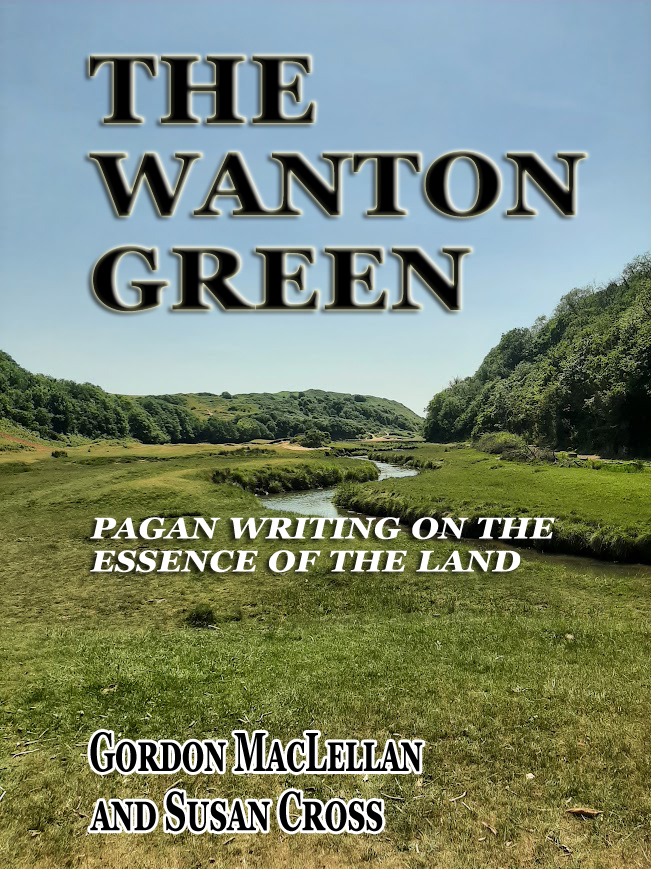
The Wanton Green
Edited by Gordon MacLellan & Susan Cross
Format: Softcover
ISBN:
£14.99 / US$23.00
Subjects: Contemporary Pagan Writings/Paganism/Spirituality.
Click Here for The Wanton Geen / USA
Click Here for The Wanton Green / UK
As our relationship with the world unravels and needs to take a new form, The Wanton Green presents a collection of inspiring, provoking and engaging essays by modern pagans about their own deep, passionate and wanton relationships with the Earth.
“Where do we locate the sacred? In a place, a meeting, memory, a momentary glimpse? The Wanton Green provides no easy answers and instead, offers a multitude of perspectives on how our relationships with the earth, the sacred, the world through which we move are forged and remade.” – Phil Hine.
About the editors:
Gordon MacLennan is a shaman, storyteller and artist whose work sets out to find ways of celebrating the relationships between people, place and wildlife. Gordon’s books include Talking to the Earth, Sacred Animals and Celebrating Nature (all with Capall Bann), StarMatter and the Piatkus Guide to Shamanism.
Susan Cross is a poet, heritage and environmental interpretation consultant and occasional pirate. About a decade ago she realised that she has probably always been some kind of animist mystic and since then has endeavoured to make that a more conscious, clearer and brighter part of her life.
The Wanton Green: Contemporary Pagan Writings On Place. Edited by Gordon MacLellan and Susan Cross (Mandrake). Since the 1970s modern forms of pagan witchcraft (Wicca) and the neo-pagan movement have defined themselves by an engagement and involvement with ecology, the environment and ‘green’ politics with their adherents claiming to be following a ‘nature religion’. This is a collection of essays on the genii loci, or ‘spirit of place’ in the natural world written by various Wiccans and neo-pagans including Shani Oates, Rufus Harrington, Emma Restall-Orr, Melissa Montgomery, Jan Fries, Julian Vayne, Barry Montgomery, Barry Paterson, Susan Greenwood, Mogg Morgan and others. The contents range from an experience of the faery folk in Devon to a psychogeographical guide to ‘occult London’. If you are interested in the non-traditional neo-pagan approach to nature and the environment then this book is recommended. – The Cauldron #144, May 2012.
